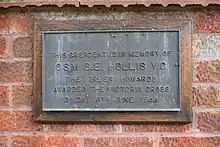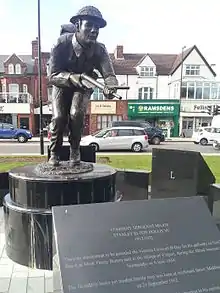Stanley Elton Hollis | |
|---|---|
 | |
| Born | 21 September 1912 Middlesbrough, North Riding of Yorkshire, England |
| Died | 8 February 1972 (aged 59) Liverton Mines, North Riding of Yorkshire |
| Buried | Acklam Cemetery, Middlesbrough 54°32′12″N 1°14′30″W / 54.5366°N 1.2417°W |
| Allegiance | |
| Service/ | |
| Years of service | 1939–1944 |
| Rank | Warrant Officer Class 2 |
| Service number | 4390973[1] |
| Unit | Green Howards |
| Battles/wars | World War II |
| Awards | Victoria Cross |
Stanley Elton Hollis VC (21 September 1912 – 8 February 1972)[2][3] was a British recipient of the Victoria Cross, the highest and most prestigious award for gallantry in the face of the enemy that can be awarded to British and Commonwealth forces.
He had the distinction of receiving the only Victoria Cross awarded on D-Day (6 June 1944).[4]
Early life
Stanley Hollis was born in Middlesbrough, North Riding of Yorkshire, England, where he lived and attended the local school until 1926. Then his parents (Edith and Alfred Hollis) moved to Robin Hood's Bay, where he worked in his father's fish and chip shop.[5]
In 1929 he was apprenticed to a Whitby shipping company, to learn to be a Navigation Officer.[6] He made regular voyages to West Africa, but in 1930 fell ill with blackwater fever, which ended his merchant navy career.[6] Returning to North Ormesby, Middlesbrough, he worked as a lorry driver, and married Alice Clixby, with whom he had a son and a daughter.[3]
Military career
In 1939 he enlisted in the Territorial Army, part of the British Army, in the 4th Battalion, Green Howards.[7] At the outbreak of the Second World War he was mobilised and transferred to the 6th Battalion, Green Howards, and went to France as part of the British Expeditionary Force in 1940, where he served as the commanding officer's despatch rider. He was promoted from lance corporal to sergeant during the evacuation from Dunkirk. He then fought from El Alamein to Tunis as part of the British Eighth Army in the North African Campaign. He was promoted to company sergeant major shortly before the invasion of Sicily in 1943, where he was wounded at the battle of Primosole Bridge.[8][3]
On D-Day, the 6th Green Howards landed on Gold Beach. As his company moved inland from the beaches after the initial landings, Hollis went with his company commander to investigate two German pillboxes which had been by-passed.[9] He rushed the first, taking all but five of the occupants prisoner; and then dealt with the second, taking 26 prisoners.[10] He next cleared a neighbouring trench. Later that day, he led an unsuccessful attack on an enemy position containing a field gun and multiple MG 42 machine guns. After withdrawing, he learned that two of his men had been left behind. He said to his commanding officer, Major Lofthouse, "I took them in. I will try to get them out." Taking a grenade from one of his men, Hollis carefully observed the enemy's pattern of behaviour and threw it at the most opportune moment. Unfortunately, he had failed to prime the grenade; but the enemy did not know that, and kept their heads down waiting for it to explode. By the time they had realised their mistake, Hollis was on top of them and had shot them down.
In September 1944 he was wounded in the leg and evacuated to England, where he was decorated by King George VI on 10 October 1944.[11]
Citation

Hollis was 31 years old, and a Warrant Officer Class II (Company Sergeant-Major) in the 6th Battalion, The Green Howards, British Army during the Second World War when the following deed took place for which he was awarded the VC:
in Normandy on 6 June 1944 Company Sergeant-Major Hollis went with his company commander to investigate two German pill-boxes which had been by-passed as the company moved inland from the beaches. "Hollis instantly rushed straight at the pillbox, firing his Sten gun into the first pill-box, He jumped on top of the pillbox, re-charged his magazine, threw a grenade in through the door and fired his Sten gun into it, killing two Germans and taking the remainder prisoners.
Later the same day... C.S.M. Hollis pushed right forward to engage the [field] gun with a PIAT [anti-tank weapon] from a house at 50 yards range... He later found that two of his men had stayed behind in the house...In full view of the enemy who were continually firing at him, he went forward alone...distract their attention from the other men. Under cover of his diversion, the two men were able to get back.
Wherever the fighting was heaviest...[he]...appeared, displaying the utmost gallantry... It was largely through his heroism and resource that the Company's objectives were gained and casualties were not heavier. ....he saved the lives of many of his men.[12]
Later life
After the war, he worked for a time as a sandblaster in a local steelworks.[13] He then became a partner in a motor repair business in Darlington, before becoming a ship's engineer from 1950 to 1955.[3] He next trained as a publican, and ran the 'Albion' public house in Market Square, North Ormesby: the pub's name was changed to 'The Green Howard'.[14] After the pub was demolished in 1970, he moved to become the tenant of the 'Holywell View' public house at Liverton Mines near Loftus.[15]
He died on 8 February 1972, and was laid to rest in Acklam Cemetery, Middlesbrough.[16]
Legacy

Hollis Crescent, a military accommodation estate, was named after him in the 1980s/90s in Strensall, North Yorkshire. A memorial plaque was put on the side of number 2 Hollis Crescent to commemorate his Victoria Cross.

A statue honouring him, sculpted by Brian Alabaster ARBS, was unveiled on 26 November 2015 by Vice Lord Lieutenant of North Yorkshire, Peter Scrope.[17] The walk-in memorial is located close to the Middlesbrough cenotaph outside the gates of Albert Park in front of the Dorman Museum.[18]
Another statue of Stanley Hollis was erected in Crapon France near the Green Howard Pub. Hollis Court, a retired/sheltered accommodation complex in Coulby Newham, Middlesbrough, is named after him.[19] His Victoria Cross was bought by medal collector Sir Ernest Harrison OBE, chairman of Racal and Vodafone. Harrison presented the medal to the Green Howards Regimental Museum in Richmond, North Yorkshire in 1997. Ten years later, he purchased, for the Green Howards, the Normandy hut which Hollis had attacked.[20]
In 2016, a school in Middlesbrough that converted to academy status, was named Hollis Academy in his honour.[21][22]
References
- ↑ Whitworth 2012, p. 130.
- ↑ Morgan 2004, p. 11.
- 1 2 3 4 Whitworth 2012, p. 131.
- ↑ "The full story of Teesside D-Day hero Stan Hollis". Middlesbrough Evening Gazette Live. 4 June 2014. Retrieved 7 June 2014.
- ↑ "Wartime Courage by Gordon Brown". Daily Telegraph. Vol. Issue 47, 409. 7 November 2007. p. 28. Archived from the original on 8 November 2007. Retrieved 26 September 2014.
- 1 2 Morgan 2004, p. 13.
- ↑ Morgan 2004, p. 14.
- ↑ Lloyd, Chris (6 June 2019). "The incredible story of D-Day hero Stan Hollis - the only man to win the VC on the 'longest day'". The Northern Echo. Retrieved 1 March 2020.
- ↑ FitzPatrick, Laura (6 June 2019). "Sergeant Major Stanley Hollis: The only man to be honoured with the Victoria Cross for his efforts on D-Day". The Telegraph. Retrieved 1 March 2020.
- ↑ "Stan Hollis and the D-Day Victoria Cross". Imperial War Museums. Retrieved 1 March 2020.
- ↑ "Victoria Cross medal goes on display". The Northern Echo. 20 April 2004. Retrieved 1 March 2020.
- ↑ "No. 36658". The London Gazette (Supplement). 15 August 1944. pp. 3807–3808.
- ↑ Hetherington, Graeme (22 September 2012). "Saluting Green Howards VC hero Stan Hollis on the centenary of his birth". The Northern Echo. Retrieved 1 March 2020.
- ↑ Morgan 2004, p. 136.
- ↑ Morgan 2004, p. 105.
- ↑ Morgan 2004, p. 143.
- ↑ "Hundreds turn out as memorial to Middlesbrough VC war hero Stanley Hollis is unveiled". Middlesbrough Evening Gazette Live Website. Retrieved 11 December 2015.
- ↑ Webber, Chris (26 November 2015). ""He saved my life, Stanley Hollis": Veteran speaks as statue of Victoria Cross winner unveiled in Middlesbrough". The Northern Echo. Retrieved 1 March 2020.
- ↑ Morgan 2004, p. 139.
- ↑ Brewerton, David (22 February 2009). "Sir Ernest Harrison". The Guardian. London. Retrieved 29 June 2010.
- ↑ Lodge, Bethany (19 October 2016). "Middlesbrough school adopts name of VC hero Stan Hollis". Gazette Live. Retrieved 1 March 2020.
- ↑ Webber, Chris (1 November 2016). "New school academy to be named after one of region's greatest war heroes". The Northern Echo. Retrieved 1 March 2020.
Bibliography
- John, Laffin (1997). British VCs of World War 2: A Study in Heroism. Sutton Publishing. ISBN 0-7509-1026-7.
- D-day Victoria Cross: Story of Sergeant Major Stanley Hollis, VC (Philip Wilkinson, 1997)
- Monuments to Courage (David Harvey, 1999)
- The Register of the Victoria Cross (This England, 1997)
- Morgan, Mike (2004). D-Day Hero; CSM Stanley Hollis VC. Stroud: Sutton. ISBN 0-7509-3694-0.
- Whitworth, Alan (2012). Yorkshire VCs. Barnsley: Pen & Sword. ISBN 978-1-84884-778-1.
External links
- The Green Howards Hollis Memorial - Hollis Hut, Ver-sur-Mer
- Location of grave and VC medal (Cleveland)
- News Item (VC medal donation to regimental museum)
- D-Day Archived 12 February 2010 at the Wayback Machine (highly detailed site on the D-Day landings)
- Stanley Hollis at Find a Grave
- Press articles